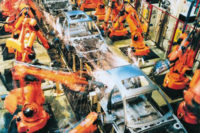Although renowned for their flexibility, robots can still be limited by their end effectors. For example, equip your favorite SCARA robot with a suction gripper, and it will be hard-pressed to perform a weld. In many cases, an assembler must quickly switch out a robot's end effector to maximize the robot's ROI. But, doing so can be surprisingly difficult, given each effector's need for I/O connectors, and utilities like electric and pneumatic power.
It was with this hurdle in mind that manufacturers began experimenting with automated tool changers back in the 1980s. In the beginning, there were problems. Tool changers could be unreliable and were apt to drop their end effectors if they lost power. However, today, tool changers are a mature technology, with fail-safe mechanisms assuring that welders or grippers will stay where they belong.
When most assemblers think of robotic tool changers, they imagine those cases in which a single robot uses multiple end effectors as part of multitask production cycle in a given cell. A single robot, for example, will employ a gripper to pick up and position a part, after which it exchanges the gripper for a welder. When the welding is complete, the robot drops off the tool and reattaches the gripper, so it can remove the piece from its fixture and pick up another.
In fact, this application represents only a fraction of the applications for which assemblers employ tool changers. For example, far more common are applications in which a robot uses a single effector for a given product run, only changing out end effectors when the product changes.
Stamping lines in particular lend themselves to this arrangement, because a different gripper must be used with each component. Given the cost of presses and dies, manufacturers want to keep them running as much as possible.
"In some cases lines are changing every 2 to 3 hours," says Bob Little, product manager for ATI Industrial Automation (Apex, NC), citing automotive door panel manufacture as an area in which tool changers can both cut costs and increase throughput. "They often have short runs of different parts. With a tool changer, within minutes the press line can be ready to start stamping out a new line of parts."
Tool changers are also finding employment in production lines producing smaller assemblies, like those found in consumer electronics or medical device manufacturing. For example, Keith Crawford, general manager for the advanced development center at Robohand (a division of DE-STA-CO Industries, Monroe, CT), says many of his company's tool changers are used for disk drive manufacture and surface mount assembly on printed circuit boards, applications in which each board style requires a unique gripper.
"A tool changer is really a magnificent tool with product life cycles dropping like they are," Crawford says, noting the high mix of products assembled by manufacturers today.
Tool changers can also be useful in situations where end effectors need to be taken off line on a regular basis for maintenance. For example, in the automotive industry, it is not unusual for an assembler to have multiple welding tools on hand so production can continue with one gun while operators are cleaning or repairing another. In this case, the tool changer justifies its expense because the welders can be swapped out in a matter of seconds, as opposed to minutes, or even hours.
In terms of design, all tool changers are pretty much the same. A robot, or "master," side is attached to the robotic arm, which mates, or attaches, to a tool-side piece, which is, in turn, attached to the end effector. Locking mechanisms generally rely on a pneumatically driven piston that forces a set of steel balls into a groove in the tool-side piece, locking it in place and clamping the two pieces together. Different fail-safe mechanisms rely on springs, or piston and groove geometry to ensure the robot- and tool-side pieces do not come apart in the event of lost air pressure.
When selecting a tool changer, it's vital to select a piece of equipment that can handle the loads to which it will be subjected. In particular, this means calculating the maximum moment load so a tool changer can resist twisting forces without excessive gapping, or wobbling. At the low end of the scale, this can mean a payload rating of less than 20 pounds and a moment capacity of 150 in.-lb. At the top end, there are grippers with payload ratings of over 1,000 pounds with maximum moments as high as 15,000 in.-lb.
When reviewing these capacities, it's important to look closely at how different suppliers rate their equipment in terms of payloads and locking strength. According to Little, manufacturers will rate their equipment according to different standards. As a result, two tool changers with the same rating may, in fact, offer markedly different performance. "Look carefully at rated payload. There is no industry standard that is being followed," he warns. "Find the factor of safety."
In terms of utilities, one of the beauties of today's tool changers is their ability to quickly connect and disconnect the air, electricity or I/O required by the end effectors to which they are attached. In the past, these capacities would be part and parcel of the actual tool changer. Today, though, suppliers are taking a modular approach, in which a manufacturer buys a tool changer equipped with a basic number of pneumatic and electrical ports and then customizes that changer with add-on modules for specific applications.
Finally, for those who don't feel the need for fully automated tool changers, there are perfectly serviceable manual versions that offer cost savings, with equivalent performance once an effector is attached.
For example, SAS Automation Ltd. (Xenia, OH) offers the SWM quick-changing mounting chuck in a number of sizes, complete with quick-disconnect pneumatic connection. When using the system, end effectors can be safely and reliably changed in just a few minutes time.
Similarly, Schunk Inc. (Morrisville, NC) not only manufactures the SWS line of automatic modular tool changers-which includes true behemoths for heavy handling and welding tasks-it also offers the HWS line of manual tool changers. These changers employ an integrated, curved lever, which turns a half-round pin that locks or releases the tool-side plate, and cost less than half as much as their automated counterparts.


